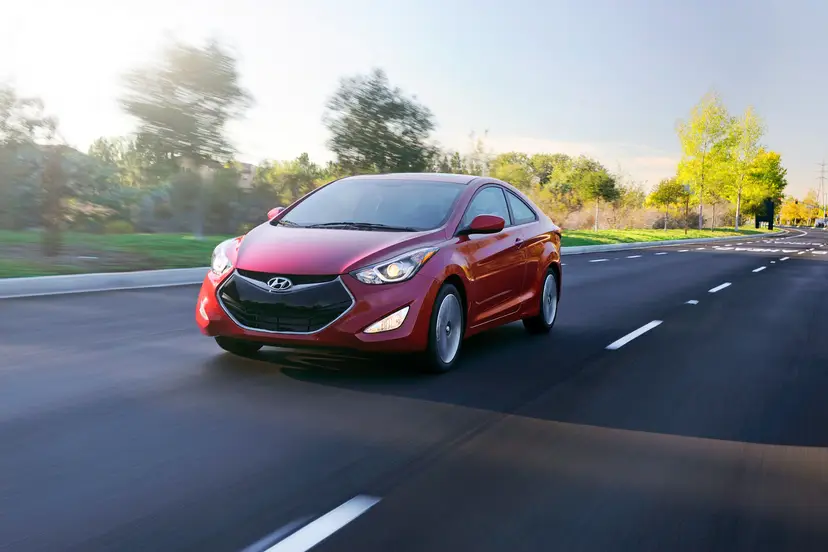
Editor’s note: Estimated mileage ratings have been lowered to reflect a Nov. 2012 EPA audit of this car’s stated mileage.
The new 2013 Hyundai Elantra coupe provides the same fuel-efficient driving experience as its sedan counterpart, and it doesn’t sacrifice much backseat comfort or cargo room.
The Elantra coupe is one of two new body styles joining the Hyundai Elantra lineup for the 2013 model year. The Elantra GT hatchback, based on a different, European platform, is the other. To see the body styles (two-door or five-door) compared, click here. The sedan is reviewed here.
The Elantra coupe starts at $18,220 including a $775 destination charge, but our uplevel SE test car’s price came to $23,870 with optional features. Competitors in this price range include the Honda Civic coupe, Scion tC and Kia Forte Koup; click here for a comparison.
Design
Hyundai rocked the compact-car segment a few years ago with its redesigned Elantra sedan, which brought a big dose of style to the market. Hyundai calls the design language “Fluidic Sculpture,” and it translates well to the coupe, which has a gracefully arcing roofline that trails off to a short deck lid. Hyundai took additional steps to make the coupe look different from the sedan, with angular fog lights and a piano-black bumper finish that gives an Audi-like impression.
Efficient Performance
The coupe accelerates well, readily keeping pace with fast-moving urban traffic. Power is similar to the Honda Civic. The gas pedal is sensitive, though, and it’s harder than normal to hold it steady, though I adjusted to it over time. The refined four-cylinder engine is an Elantra coupe highlight.
The optional six-speed automatic (a six-speed manual is standard) shifts smoothly and is always willing to downshift when you need more power. Whether you press the gas pedal partway down or all the way to the floor, the transmission quickly drops a gear or more. A lot of modern automatics make you wait a moment before heeding your call, so it’s nice to experience one like this.
With an EPA-estimated fuel economy of 27/37 mpg city/highway, the automatic-equipped Hyundai Elantra coupe is nearly as efficient as its sedan counterpart, which is rated 28/38 mpg (actual mileage may vary).
The automatic transmission includes an ActiveECO feature. The system is designed to smooth spikes in throttle application to improve real-world efficiency, Hyundai says. When ActiveECO is on, gas pedal sensitivity decreases, requiring you to press the pedal down farther when accelerating, but the drop-off in response doesn’t significantly degrade the driving experience.
Ride & Handling
The SE trim level comes with a sport suspension that Hyundai says has been tuned to the car’s 17-inch low-profile tires. You feel bumps and ruts, but true harshness is damped before it reaches the cabin. The Elantra stays flat in corners, but the ride is comfortable.
The car turns in quickly, giving it a nimble feel, and plenty of power-steering assist means it doesn’t take much effort to turn the wheel. On the downside, there’s little steering feedback, and what’s present has an unrewarding artificialness to it.
The Inside
The coupe’s cabin has the same design theme as the Hyundai Elantra sedan, with a distinctive control panel that ties the upper portion of the dashboard together with the center console. Despite the angular design, panel fit and alignment is impressive. The dashboard is made of soft-touch material, but Hyundai’s money would have been better spent on the upper door trim — a place where you might want to rest your arm — which is still hard plastic.
Manually adjustable front bucket seats are standard. They aren’t overly firm, and they’re wide enough that you won’t feel the side bolsters most of the time.
The amount of rear seat space is a pleasant surprise. From the outside, the coupe’s backseat looks tiny and cramped, but it’s actually quite roomy and comfortable — even for a 6-foot-1 passenger like me. Of course, it’s not as easy to get into the backseat as it is in the Elantra sedan, but the coupe really doesn’t give up much to the four-door in terms of comfort, and that’s impressive.
The coupe doesn’t lose any trunk space compared with the sedan, either, as both measure 14.8 cubic feet. The coupe’s standard 60/40-split backseat folds to reveal a large opening between the trunk and passenger area, enhancing cargo-carrying versatility.
Safety
As a new model, the Hyundai Elantra coupe hasn’t been crash-tested yet.
Standard safety features include antilock brakes and an electronic stability system, which are required on new vehicles as of the 2012 model year. Also standard are side-impact airbags for the front seats and side curtain airbags. A backup camera is optional.
For a full list of safety features, check out the Features & Specs page, and see how child-safety seats fit with our Car Seat Check.
Elantra Coupe in the Market
Mainstream compact coupes tend to stand in the shadows of their sedan siblings, and both Chevrolet and Ford recently dropped coupe body styles from their compact lineups following redesigns.
Despite U.S. car shoppers’ supposed dislike of hatchbacks, the body style has instead gained ground in the compact segment, with new sporty-looking models like the Ford Focus hatch and Elantra GT. Versatility is one of the most appealing aspects of a hatchback, and the Hyundai Elantra coupe impressed on that front, too, by retaining the sedan’s roominess. It represents another solid effort in a new segment for Hyundai.
| Send Mike an email |








































